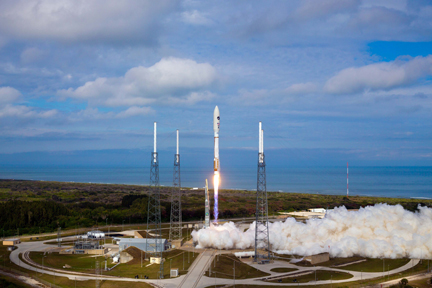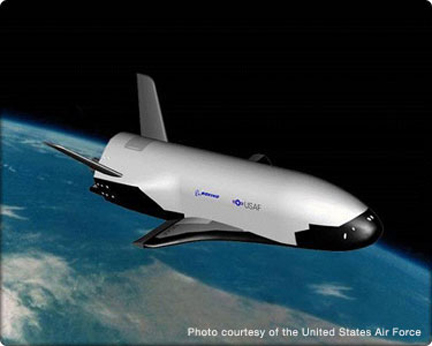Air Force launches unmanned spaceplane on third flight
12/11/2012 06:18 PM Filed in: Space News | Military Space
By WILLIAM HARWOOD
CBS News
A United Launch Alliance Atlas 5 rocket blasted off from the Cape Canaveral Air Force Station Tuesday, boosting an unmanned military spaceplane into orbit for the program's third classified mission.
Despite an initially gloomy forecast calling for a 70 percent chance of bad weather, conditions were well within acceptable limits as the countdown ticked toward zero and the rocket's Russian-designed RD-180 first-stage engine roared to life on time at 1:03 p.m. EST (GMT-5).
The weight and requirements of the X-37B spaceplane did not require the use of strap-on solid-fuel boosters and as a result, the Atlas 5's climb out from Space Launch Complex 41 appeared relatively sedate. But the rocket quickly accelerated as it consumed propellant and shed weight, disappearing from view to the east a few minutes after liftoff.
United Launch Alliance mission control commentary ended a few moments after shutdown of the Centaur second stage engine, before the 29-foot-long winged orbiter was released to fly on its own.
The X-37B, one of two Orbital Test Vehicles, or OTVs, is equipped with its own maneuvering engines, a small payload bay and a solar power boom. Like the now-retired space shuttle, the OTV uses ceramic tiles to protect the craft from the intense heat of re-entry.
While no details were provided, United Launch Alliance said the ascent was successful.
"A United Launch Alliance Atlas V rocket successfully launched the third Orbital Test Vehicle for the Air Force's Rapid Capabilities Office at 1:03 p.m. EST," the company said. "The OTV, also known as the X-37B, supports space experimentation, risk reduction and concept of operations development for long duration and reusable space vehicle technologies."
NASA developed the original idea of a small unmanned orbiter, which was built by Boeing Corp.'s Phantom Works division. But the program was turned over to the Pentagon's Defense Advanced Research Projects Agency, or DARPA, in 2004.
The Air Force then took over in 2006. The first X-37B, the same one launched Tuesday, took off on the program's initial orbital test flight April 22, 2010. The spacecraft spent nearly 225 days in orbit before gliding to a computer-controlled touchdown at Vandenberg Air Force Base, Calif.
A second X-37B was launched on March 5, 2011. It spent 469 days in space, landing June 16, 2012, at Vandenberg.
"We couldn't be more pleased with the strides we've made in this program and the success of the X-37B vehicle on the first two flights," Richard McKinney, Deputy Under Secretary of the Air Force for Space, said in a statement after Tuesday's launching.
"However, it is important to keep in mind that this is an experimental vehicle and a third mission is still relatively young for a test program. This is the first re-flight of a vehicle so that is certainly a key objective for us. We have only just begun what is a very systematic checkout of the system."
The unmanned orbiter is based on the same lifting body design used for the space shuttle and flies a similar re-entry trajectory. But the X-37B features more lightweight composite materials, improved wing insulation and tougher heat-shield tiles that "are significantly more durable than the first generation tiles used by the space shuttle," according to a Boeing website description. "All avionics on the X-37B are designed to automate all de-orbit and landing functions."
The X-37B features a scaled-down 4-foot by 7-foot payload bay. But unlike NASA's manned orbiter, which relied on fuel cells for electrical power, the Air Force spaceplane is equipped with a deployable solar array that permits it to remain in orbit for long-duration missions.
But exactly what the X-37B does in orbit is a mystery.
"As with many other advanced technology test programs, some details of the mission and test requirements are classified or sensitive," an Air Force spokeswoman told SpaceflightNow.com. "The focus of the program remains on vehicle capabilities and proving the utility and cost effectiveness of a reusable spacecraft.
"One of the most promising aspects of the X-37B OTV is it enables us to examine a payload system or technology in the environment in which it will perform its mission and inspect them when we bring them back to Earth."
Getting the hardware back for detailed analysis enables "significantly better learning than can be achieved by remote telemetry alone," she said. "Experiments can then be modified and reflown, allowing us to mature technology faster."
The first two X-37B missions ended at Vandenberg, but officials did not rule out the possibility that the third mission might end on the Kennedy Space Center's 3-mile-long shuttle runway.
"We're seeking to leverage previous space shuttle investments and are investigating the possibility of using the former shuttle infrastructure for X-37B OTV landing operations, potentially as early as for the landing of OTV 3," the Air Force spokeswoman said. "Those investigations are in an early state, and any specifics will not be known for some time."
CBS News
A United Launch Alliance Atlas 5 rocket blasted off from the Cape Canaveral Air Force Station Tuesday, boosting an unmanned military spaceplane into orbit for the program's third classified mission.
Despite an initially gloomy forecast calling for a 70 percent chance of bad weather, conditions were well within acceptable limits as the countdown ticked toward zero and the rocket's Russian-designed RD-180 first-stage engine roared to life on time at 1:03 p.m. EST (GMT-5).
The weight and requirements of the X-37B spaceplane did not require the use of strap-on solid-fuel boosters and as a result, the Atlas 5's climb out from Space Launch Complex 41 appeared relatively sedate. But the rocket quickly accelerated as it consumed propellant and shed weight, disappearing from view to the east a few minutes after liftoff.
 |
| A United Launch Alliance Atlas 5 rocket blasted off from the Cape Canaveral Air Force Station Tuesday, boosting an unmanned X-37B spaceplane into orbit for a classified military mission. (Credit: United Launch Alliance) |
The X-37B, one of two Orbital Test Vehicles, or OTVs, is equipped with its own maneuvering engines, a small payload bay and a solar power boom. Like the now-retired space shuttle, the OTV uses ceramic tiles to protect the craft from the intense heat of re-entry.
While no details were provided, United Launch Alliance said the ascent was successful.
"A United Launch Alliance Atlas V rocket successfully launched the third Orbital Test Vehicle for the Air Force's Rapid Capabilities Office at 1:03 p.m. EST," the company said. "The OTV, also known as the X-37B, supports space experimentation, risk reduction and concept of operations development for long duration and reusable space vehicle technologies."
NASA developed the original idea of a small unmanned orbiter, which was built by Boeing Corp.'s Phantom Works division. But the program was turned over to the Pentagon's Defense Advanced Research Projects Agency, or DARPA, in 2004.
The Air Force then took over in 2006. The first X-37B, the same one launched Tuesday, took off on the program's initial orbital test flight April 22, 2010. The spacecraft spent nearly 225 days in orbit before gliding to a computer-controlled touchdown at Vandenberg Air Force Base, Calif.
A second X-37B was launched on March 5, 2011. It spent 469 days in space, landing June 16, 2012, at Vandenberg.
"We couldn't be more pleased with the strides we've made in this program and the success of the X-37B vehicle on the first two flights," Richard McKinney, Deputy Under Secretary of the Air Force for Space, said in a statement after Tuesday's launching.
 |
| An artist's concept of the X-37B in orbit. (Credit: U.S. Air Force) |
The unmanned orbiter is based on the same lifting body design used for the space shuttle and flies a similar re-entry trajectory. But the X-37B features more lightweight composite materials, improved wing insulation and tougher heat-shield tiles that "are significantly more durable than the first generation tiles used by the space shuttle," according to a Boeing website description. "All avionics on the X-37B are designed to automate all de-orbit and landing functions."
The X-37B features a scaled-down 4-foot by 7-foot payload bay. But unlike NASA's manned orbiter, which relied on fuel cells for electrical power, the Air Force spaceplane is equipped with a deployable solar array that permits it to remain in orbit for long-duration missions.
But exactly what the X-37B does in orbit is a mystery.
"As with many other advanced technology test programs, some details of the mission and test requirements are classified or sensitive," an Air Force spokeswoman told SpaceflightNow.com. "The focus of the program remains on vehicle capabilities and proving the utility and cost effectiveness of a reusable spacecraft.
"One of the most promising aspects of the X-37B OTV is it enables us to examine a payload system or technology in the environment in which it will perform its mission and inspect them when we bring them back to Earth."
Getting the hardware back for detailed analysis enables "significantly better learning than can be achieved by remote telemetry alone," she said. "Experiments can then be modified and reflown, allowing us to mature technology faster."
The first two X-37B missions ended at Vandenberg, but officials did not rule out the possibility that the third mission might end on the Kennedy Space Center's 3-mile-long shuttle runway.
"We're seeking to leverage previous space shuttle investments and are investigating the possibility of using the former shuttle infrastructure for X-37B OTV landing operations, potentially as early as for the landing of OTV 3," the Air Force spokeswoman said. "Those investigations are in an early state, and any specifics will not be known for some time."